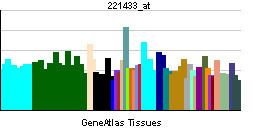Species Human Entrez 26291 | Human Mouse Ensembl ENSG00000105550 | |
 | ||
Aliases FGF21, fibroblast growth factor 21 External IDs MGI: 1861377 HomoloGene: 10428 GeneCards: FGF21 | ||
Fibroblast growth factor 21 is a protein that in mammals is encoded by the FGF21 gene. The protein encoded by this gene is a member of the fibroblast growth factor (FGF) family and specifically a member of the "endocrine" subfamily which includes FGF23 and FGF15/19.
Contents
FGF family members possess broad mitogenic and cell survival activities and are involved in a variety of biological processes including embryonic development, cell growth, morphogenesis, tissue repair, tumor growth and invasion. FGFs act through a family of four FGF receptors. Binding is complicated and requires both interaction of the FGF molecule with an FGF receptor and binding to heparin through an heparin binding domain. Endocrine FGFs lack a heparin binding domain and thus can be released into the circulation. FGF21 action through one of the FGF21 receptors thus requires interaction with a co-receptor, designated β-klotho.
Regulation
FGF21 is specifically induced by HMGCS2 activity. The oxidized form of ketone bodies (acetoacetate) in a cultured medium also induced FGF21, possibly via a SIRT1-dependent mechanism. HMGCS2 activity has also been shown to be increased by deacetylation of lysines 310, 447, and 473 via SIRT3 in the mitochondria.
While FGF21 is expressed in numerous tissues, including liver, brown adipose tissue, white adipose tissue and pancreas, circulating levels of FGF21 are derived specifically from the liver in mice. In liver FGF21 expression is regulated by PPARα and levels rise substantially with both fasting and consumption of ketogenic diets.
LXR represses FGF21 in humans via an LXR response element located from -37 to -22 bp on the human FGF21 promoter.
Function
FGF21 stimulates glucose uptake in adipocytes but not in other cell types. This effect is additive to the activity of insulin. FGF21 treatment of adipocytes is associated with phosphorylation of FRS2, a protein linking FGF receptors to the Ras/MAP kinase pathway. FGF21 injection in ob/ob mice results in an increase in Glut1 in adipose tissue. FGF21 also protects animals from diet-induced obesity when overexpressed in transgenic mice and lowers blood glucose and triglyceride levels when administered to diabetic rodents. Treatment of animals with FGF21 results in increased energy expenditure, fat utilization and lipid excretion.
Beta Klotho (KLB) functions as a cofactor essential for FGF21 activity.
In cows plasma FGF21 was nearly undetectable in late pregnancy (LP), peaked at parturition, and then stabilized at lower, chronically elevated concentrations during early lactation (EL). Plasma FGF21 was similarly increased in the absence of parturition when an energy-deficit state was induced by feed restricting late-lactating dairy cows, implicating energy insufficiency as a cause of chronically elevated FGF21 in EL. The liver was the major source of plasma FGF21 in early lactation with little or no contribution by WAT, skeletal muscle, and mammary gland. Meaningful expression of the FGF21 coreceptor β-Klotho was restricted to liver and WAT in a survey of 15 tissues that included the mammary gland. Expression of β-Klotho and its subset of interacting FGF receptors was modestly affected by the transition from LP to EL in liver but not in WAT.
Clinical significance
Serum FGF-21 levels were significantly increased in patients with type 2 diabetes mellitus (T2DM) which may indicate a role in the pathogenesis of T2DM. Elevated levels also correlate with liver fat content in non-alcoholic fatty liver disease and positively correlate with BMI in humans suggesting obesity as a FGF21-resistant state.
Animal studies
Mice lacking FGF21 fail to fully induce PGC-1α expression in response to a prolonged fast and have impaired gluconeogenesis and ketogenesis.
FGF21 stimulates phosphorylation of fibroblast growth factor receptor substrate 2 and ERK1/2 in the liver. Acute FGF21 treatment induced hepatic expression of key regulators of gluconeogenesis, lipid metabolism, and ketogenesis including glucose-6-phosphatase, phosphoenol pyruvate carboxykinase, 3-hydroxybutyrate dehydrogenase type 1, and carnitine palmitoyltransferase 1α. In addition, injection of FGF21 was associated with decreased circulating insulin and free fatty acid levels. FGF21 treatment induced mRNA and protein expression of PGC-1α, but in mice PGC-1α expression was not necessary for the effect of FGF21 on glucose metabolism.
In mice FGF21 is strongly induced in liver by prolonged fasting via PPAR-alpha and in turn induces the transcriptional coactivator PGC-1α and stimulates hepatic gluconeogenesis, fatty acid oxidation, and ketogenesis. FGF21 also blocks somatic growth and sensitizes mice to a hibernation-like state of torpor, playing a key role in eliciting and coordinating the adaptive starvation response. FGF21 expression is also induced in white adipose tissue by PPAR-gamma, which may indicate it also regulates metabolism in the fed state.
Activation of AMPK and SIRT1 by FGF21 in adipocytes enhanced mitochondrial oxidative capacity as demonstrated by increases in oxygen consumption, citrate synthase activity, and induction of key metabolic genes. The effects of FGF21 on mitochondrial function require serine/threonine kinase 11 (STK11/LKB1), which activates AMPK. Inhibition of AMPK, SIRT1, and PGC-1α activities attenuated the effects of FGF21 on oxygen consumption and gene expression, indicating that FGF21 regulates mitochondrial activity and enhances oxidative capacity through an LKB1-AMPK-SIRT1-PGC-1α-dependent mechanism in adipocytes, resulting in increased phosphorylation of AMPK, increased cellular NAD+ levels and activation of SIRT1 and deacetylation of SIRT1 targets PGC-1α and histone 3.
